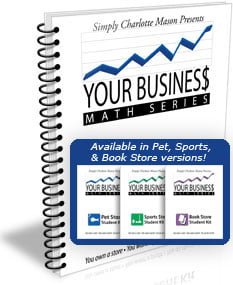As with all elementary Montessori work, the idea is to get the child exploring and learning of his own accord - provide him the keys and let him do the unlocking ;)
Along that vein, when Legoboy came across some information about Your Business Math, he was really excited! And started saving his money for it.

While business math is ideal for the adolescent age, there is nothing wrong with some sidework in the business world at the elementary age too! They have three options: pet store, book store, or sports store. We have the e-book version of the pet store.
There is a bit of printing with the e-book, but it saved shelfspace and allowed us to just print what we need so I'm good ;) You can print straight from the pdf they send you or they have links on their website to download just the needed pages.
He got started on it the week before Thanksgiving and while he would be happy to fly right through it, I am intentionally slowing him down so that we truly focus in on each step of the process.
You work in "months" which take about an hour each to do if you fly straight through and a bit longer if you are more mindful.
He chose a binder and some dividers; drew out a logo and selected a name for his store:
 |
| The first divider - all inventory sheets, order forms, customer orders,, ledgers, etc. for each month are behind their own tab. |
We like it. I wish it was a bit more intense, so we could more easily beef it up and make it a younger adolescent experience - but this is solidly 8-12 as their website specifies - and I could see most Montessori 11 and 12 years old wishing for more intensity.
The nice thing with families - is that each child can have their own store - the instructions are the same, the order details are different - and they can place orders with each other. There are other ways to provide variations, such as other family members placing pretend orders, choosing not to accept a program-provided order on moral grounds (ie one customer wants to feed his animal purchase to his other animal, so would you as a *pet* store owner want to allow that, etc). The instructions note when you should develop certain policies such as these. And there are certainly your own variations you can make as you like.
There are chance cards and cards for "additional in-store sales" (AISS cards). These also add some variations and allow for varying situations.
At the end of each month, profit and loss are calculated; as well as at the end of the year. Evaluate how things went, what worked, what didn't - and how would this all work in the real world.
Down-sides:
- The ledger system is a single-line - good for some purposes, but some accounting records need double-entry - this might be an item to add to an adolescent experience, following using this program in elementary - build up complexity in increments.
- The labels of debit and credit are incorrect - reflecting what your personal bank statement looks like rather than what a real business ledger account would look like. This is easy to fix by simply crossing them out and re-writing them - or leaving those words out altogether. It is also a good discussion point for the children - when is a debit "money in" and when it is "money out".
- the orders have no actual dates, so we make them up. The program has you calculating all ledger entries at the end of each "month" instead of as it happens. This has benefits and drawbacks in the real world. Another discussion point for the children.
- the chance and AISS cards can be a tad confusing - how to record them for example: if you had $450 in additional in-store sales, what inventory are you replacing? It doesn't say. So we chose to mark it down as services rendered - perhaps pet-boarding for the day or the weekend; or delivery service. We just have to ignore the other expenses (extra food used, gas, mileage) - this is where this is program is solidly elementary, but would not be appropriate for adolescence who want real world experience. So we make the adjustments, gain the experience and move on.
- If a chance card says increase earnings by 10% - 10% of WHAT!? It doesn't say, so I created another set of chance cards, that when this sort of card is picked, he draws from the new stack to tell us the percentage of what - AISS, monthly profit/loss, total income for the month, etc.
For what it is and what it purports to do, it is fun, lays a good foundation and introduces the practical purpose of various math concepts. Can't beat it! It would be great to see something for middle schoolers with more of the "trickiness" included - perhaps that is something to look forward to!

